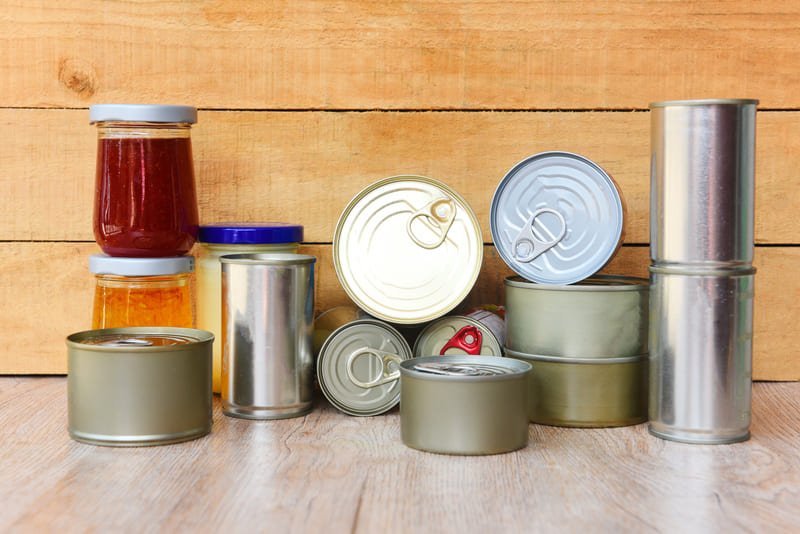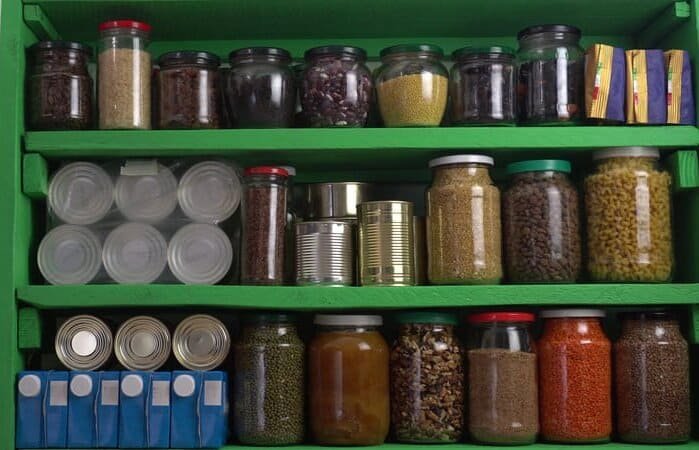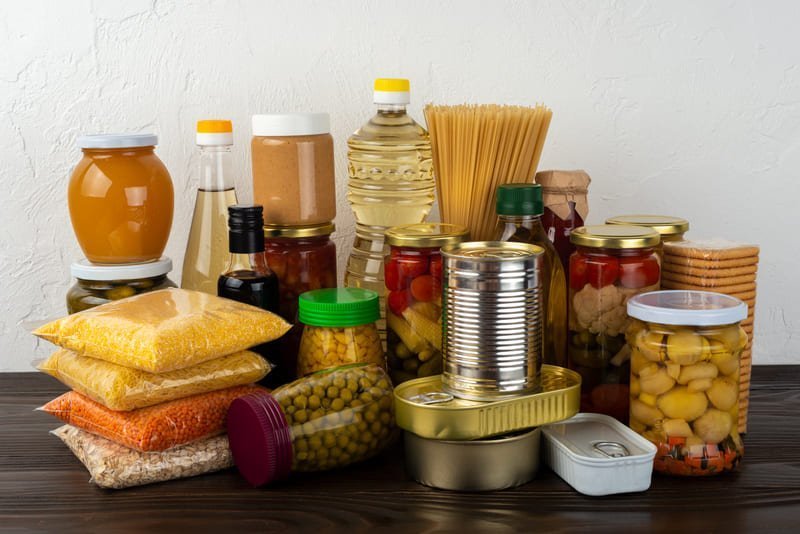Emergency preparedness is crucial in ensuring the safety and well-being of yourself and your loved ones during times of crisis. One important aspect of emergency prep is having an adequate supply of prepper food. Stocking up on the best prepper food options can provide you with the necessary nutrition and energy to sustain you in an emergency situation. In this article, I will explore the top prepper food essentials, including their long shelf life, affordability, and essential nutrients.
Key Takeaways:
- Choose prepper food with a long shelf life to ensure it remains fresh and usable for extended periods.
- Consider the affordability of prepper food supplies to ensure you can stock up without breaking the bank.
- Look for prepper food options that provide essential nutrients to support your health and well-being during emergencies.
- Read prepper food reviews to gauge the quality and taste of different products before making a purchase.
- Include prepper pantry essentials, such as canned meats, fruits, vegetables, and high-energy snacks, in your emergency food supply.
- Stockpile enough food for emergencies to sustain you and your family for an extended period.
Why Stock Up on Emergency Food?
In times of crisis, such as natural disasters or disease outbreaks, having a stockpile of emergency food is essential.
During these emergencies, your dietary needs may change, requiring higher-energy and high-protein foods to fuel your body. In addition, it is important to consume nutritious foods that can help maintain good health, especially when resources are limited.
Stocking up on emergency food allows you to meet your basic nutritional needs and provide variety and nutrients to sustain you during an emergency.
When disaster strikes, access to fresh food may be limited, making it crucial to have a supply of emergency food on hand. When you stock up on emergency food, you ensure that you and your family have access to nourishing meals during challenging times.
In addition, emergencies can be unpredictable, and you may need to stay indoors for an extended period. Having an emergency food supply allows you to remain self-sufficient and reduces the need to venture out, ensuring your safety.
Furthermore, emergency food is specifically designed to have a long shelf life, often ranging from several months to several years. This means you can store it for an extended period without worrying about spoilage or expiration dates.
Emergency food typically comes in convenient packaging that is easy to store and transport. Whether you need to evacuate or shelter in place, having an emergency food supply ensures that you have access to nutritious meals wherever you are.
Stocking up on emergency food is a proactive measure that demonstrates preparedness and responsibility. It allows you to prioritize the well-being of yourself and your loved ones, even in the face of adversity.
In conclusion, emergency food is a vital component of your emergency preparedness kit. It provides sustenance, nutrition, and peace of mind during times of crisis. By stocking up on emergency food, you can ensure that you and your family are well-prepared to face any natural disaster, disease outbreak, or unforeseen emergency that may come your way.
Non-perishable Foods with Long Shelf Life
 When it comes to building your emergency food supply, non-perishable foods with a long shelf life are essential. These foods can be stored for extended periods, providing you with peace of mind even outside of specific disaster seasons. Here are some examples of non-perishable foods that you should consider stockpiling:
When it comes to building your emergency food supply, non-perishable foods with a long shelf life are essential. These foods can be stored for extended periods, providing you with peace of mind even outside of specific disaster seasons. Here are some examples of non-perishable foods that you should consider stockpiling:
- Canned meats: Tuna, chicken, and spam are great sources of protein and can be easily incorporated into various meals.
- Canned fruits and vegetables: These provide essential vitamins and minerals, adding variety and nutrition to your emergency meals.
- Crackers: They are a versatile option for snacking or as a base for canned spreads or cheeses.
- Cereals: They are not only a convenient breakfast choice but can also be enjoyed as a snack or light meal.
- Granola bars: These provide a quick source of energy and can be easily stored in your emergency kit for on-the-go nutrition.
- Dried fruits: Compact and lightweight, dried fruits are a healthy and delicious option to satisfy your sweet cravings.
- Canned beans: These are a great source of plant-based protein and can be used in a variety of recipes.
Remember to regularly check the expiration dates of your stored food items and rotate your stockpile to ensure freshness and prevent waste. Additionally, it is crucial to have a can opener available in your emergency kit to access the contents of canned foods.
Stockpile Food Expiration Dates
Understanding expiration dates is essential to maintaining a reliable emergency food supply. While some canned and packaged foods can last for years past their expiration dates, it’s crucial to use your judgment and assess the condition of the food before consuming it. Here is a general guide to interpreting common food labeling terms:
| Term | Meaning |
|---|---|
| Expiration Date | The food should not be consumed after this date as it may pose health risks. |
| Best By Date | The food is at its peak quality before this date, but it is still safe to consume afterwards if properly stored. |
| Sell By Date | This date indicates to retailers when the product should be taken off the shelves. It can still be safe to consume afterwards if stored correctly. |
Remember to always use your senses to evaluate the condition of the food, including its appearance, smell, and taste, before consuming it, especially when it approaches or surpasses the expiration date.
Easy-to-Prepare and Nutritious Foods
 In an emergency, it may not be possible to rely on utilities or cooking appliances for food preparation. Therefore, it is important to include easy-to-prepare and nutritious foods in your emergency food supply. This includes foods that can be eaten as-is or require minimal reheating or rehydrating. High-energy foods such as peanut butter, crackers, and granola bars are ideal for snacking.
In an emergency, it may not be possible to rely on utilities or cooking appliances for food preparation. Therefore, it is important to include easy-to-prepare and nutritious foods in your emergency food supply. This includes foods that can be eaten as-is or require minimal reheating or rehydrating. High-energy foods such as peanut butter, crackers, and granola bars are ideal for snacking.
Additionally, choosing foods with high fiber content, vitamins, and minerals can help maintain your overall health and well-being during an emergency. Consider incorporating the following into your emergency food supply:
- Fruits and vegetables: Opt for canned fruits and vegetables, as they have a longer shelf life and still retain essential nutrients.
- Protein sources: Canned meat, like chicken or tuna, provides a good source of protein and can be eaten as-is or added to other dishes.
- Dried fruits: These are a nutritious and portable snack, packed with vitamins and minerals. They also have a longer shelf life compared to fresh fruits.
- Whole grains: Stock up on quick-cooking oats, rice, and whole-grain crackers. These foods provide carbohydrates for energy and fiber for digestion.
By including a variety of easy-to-prepare and nutritious foods in your emergency food supply, you can ensure that you have the necessary sustenance to keep you going during challenging times. Remember to periodically check the expiration dates of your food stash and rotate items as needed to maintain freshness.
Benefits of Easy-to-Prepare and Nutritious Foods:
Choosing easy-to-prepare and nutritious foods for your emergency food supply has several benefits:
- Convenience: Easy-to-prepare foods can be enjoyed without the need for cooking or extensive preparation, making them convenient options during emergencies.
- Quick energy: High-energy foods provide a quick source of energy when you need it most, helping to keep you alert and focused.
- Improved digestion: Foods high in fiber promote healthy digestion, preventing constipation and other digestive issues that may arise during stress or changing dietary habits.
- Essential nutrients: Nutrient-rich foods provide essential vitamins and minerals to support your overall health and well-being, even in challenging circumstances.
With a carefully planned emergency food supply that includes easy-to-prepare and nutritious foods, you can face challenging situations with confidence, knowing that you have the nourishment your body needs to thrive.
| Easy-to-Prepare and Nutritious Foods | Benefits |
|---|---|
| Fruits and vegetables | Rich in vitamins and minerals |
| Protein sources | Provides essential amino acids |
| Dried fruits | Portable and packed with nutrients |
| Whole grains | Good source of carbohydrates and fiber |
By incorporating easy-to-prepare and nutritious foods into your emergency food supply, you can prioritize your health and well-being during uncertain times. These foods not only provide sustenance but also offer convenience and essential nutrients to support your body’s needs. Remember to rotate your food supply regularly and replenish items as necessary to ensure freshness and optimal nutrition.
Considerations for Short-Term and Long-Term Supply
 During an emergency, it is crucial to have a well-prepared food supply that meets the short-term and long-term needs of you and your family. Depending on the duration of the emergency, you will need to plan accordingly to ensure you have enough food to sustain yourselves.
During an emergency, it is crucial to have a well-prepared food supply that meets the short-term and long-term needs of you and your family. Depending on the duration of the emergency, you will need to plan accordingly to ensure you have enough food to sustain yourselves.
For short-term emergencies, it is recommended to have at least a three-day supply of non-perishable foods that do not require refrigeration or extensive preparation. In this short period, it is essential to focus on having easily accessible and ready-to-eat options to meet your immediate nutrition needs.
Short-term emergency food considerations:
- Canned meats, fruits, and vegetables provide essential nutrients and are easy to store and consume. They can be eaten as-is or added to other dishes to enhance flavor and variety.
- High energy foods like peanut butter, granola bars, and nuts can provide a quick boost of energy and satisfy hunger between meals.
- Dried fruits and nuts are a great source of vitamins and minerals, and they have a long shelf life.
For long-term emergencies, such as natural disasters or other extended crises, it is important to increase the quantity of staple foods in your emergency supply. Having a two-week emergency supply ensures that you and your family have enough food to sustain yourselves during this challenging period.
Long-term emergency food considerations:
- Stock up on staple foods that you normally consume, such as rice, pasta, beans, and oats. These foods provide a good source of carbohydrates and can be the foundation of many meals.
- Include a variety of canned goods, such as canned fruits, vegetables, and soups, to add flavor, nutrients, and convenience to your meals.
- Consider any dietary restrictions or special needs of individuals in your household when planning your food supply. If someone has dietary restrictions, ensure you have alternative options available.
By considering both short-term and long-term emergency food needs, you can ensure that you and your family are well-prepared and have the necessary nutrition to sustain yourselves during an emergency.
| Short-Term Emergency Food | Long-Term Emergency Food |
|---|---|
| Canned meats, fruits, and vegetables | Staple foods (rice, pasta, beans) |
| High energy foods (peanut butter, granola bars) | Canned goods (fruits, vegetables, soups) |
| Dried fruits and nuts | Dietary-specific options |
Cooking and Storage Without Electricity
 In the event of a power outage, cooking without electricity becomes a challenge. It is important to have alternative cooking options available to ensure that you can still prepare meals in emergency situations. Here are some emergency cooking options:
In the event of a power outage, cooking without electricity becomes a challenge. It is important to have alternative cooking options available to ensure that you can still prepare meals in emergency situations. Here are some emergency cooking options:
- Fire: Building a fire outdoors can provide heat for cooking. Make sure to follow safety guidelines and use a fire pit or designated area to avoid accidents.
- Charcoal Grill: A charcoal grill can be an excellent option for cooking without power. It provides a controlled heat source and allows for grilling, roasting, and even baking.
- Camp Stove: A portable camp stove is lightweight and easy to use. It runs on propane or other fuels and can be a reliable source of cooking heat during emergencies or outdoor adventures.
While alternative cooking methods are essential, it is also advisable to include shelf-stable foods in your emergency food supply that can be consumed without cooking. These foods provide convenience and nutrition even without access to cooking facilities. Some examples of shelf-stable foods to consider include:
- Ready-to-eat canned meats
- Canned fruits and vegetables
- Crackers
- Granola bars
- Dried fruits
Having a combination of alternative cooking options and shelf-stable foods ensures that you are prepared to meet your nutritional needs during an emergency, even without electricity.
| Emergency Cooking Options | Benefits |
|---|---|
| Fire | – Provides heat for cooking – Allows outdoor cooking – Can be used for various cooking methods |
| Charcoal Grill | – Controlled heat source – Suitable for grilling, roasting, and baking – Portable and versatile |
| Camp Stove | – Lightweight and portable – Runs on propane or other fuels – Reliable source of cooking heat |
Conclusion
When it comes to emergency preparedness, having the best prepper food is essential for your safety and well-being. By stocking up on foods with a long shelf life, you can ensure that your emergency food supply remains fresh and ready for use whenever you need it. It’s important to choose nutritious options that can provide you with the necessary vitamins, minerals, and energy to sustain you during times of crisis.
Opting for easy-to-prepare foods is crucial, especially when cooking without power. Including a variety of shelf-stable foods in your stockpile ensures that you have nutritious options available, even in challenging circumstances. Ready-to-eat canned meats, fruits, and vegetables, along with non-perishable items like crackers, granola bars, and dried fruits, can keep you nourished without the need for cooking facilities.
By following these guidelines and building a well-rounded emergency food supply, you can be prepared for any situation that may arise. Prioritizing emergency preparedness and choosing the best prepper food options will provide you with peace of mind, knowing that you are ready to face any crisis or disaster head-on. Remember, your safety and well-being are in your hands, so start building your emergency food supply today.
FAQ
What is the importance of stockpiling emergency food?
Stockpiling emergency food ensures that you have an adequate food supply to sustain yourself and your loved ones during times of crisis, such as natural disasters or disease outbreaks.
What types of foods should be included in an emergency food supply?
Non-perishable foods with a long shelf life, such as canned meats, fruits and vegetables, crackers, cereals, granola bars, dried fruits, and canned beans, should be included in an emergency food supply.
Why is it important to choose easy-to-prepare and nutritious foods for an emergency food supply?
In an emergency, resources may be limited and cooking facilities may not be available. Choosing easy-to-prepare foods ensures that you can still consume nutritious meals to meet your dietary needs.
How much emergency food should I stockpile for different durations of emergencies?
It is recommended to have at least a three-day supply of non-perishable foods for short-term emergencies and enough supplies for at least two weeks for long-term emergencies.
What should I include in my emergency food supply if cooking without electricity is necessary?
Ready-to-eat canned meats, fruits, and vegetables, along with other non-perishable foods like crackers, granola bars, and dried fruits, can provide necessary nutrition even without cooking facilities.












